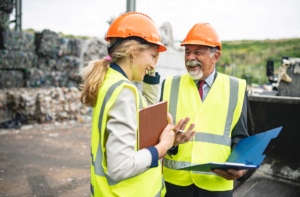Sustainability-Minded Building: A Guide for Future-Forward Business Leaders
Today’s business leaders have a unique responsibility, and opportunity, to shape a more sustainable world. One area where you can make a significant impact is in how you construct and manage your facilities.
Our Chief Sustainability Officer, Cameron Funk, recently had the opportunity to contribute to the Green Sports Alliance’s (GSA) exceptional new playbook, Building for the Next Generation: Journey to Zero, sharing his sustainability-focused principles for new building projects. The goal? To create facilities that aren’t just functional and attractive, but also respectful to our environment and future generations.
In the playbook, the GSA highlights three areas where businesses can make an impact when developing new buildings and facilities.
1) Water Conservation & Management
We all know that water is a precious resource. Thus, it’s important to consider water-saving technologies and responsible management practices when designing new facilities. The GSA recommends being open to new processes and technologies that improve water efficiencies, water capture, and water reuse.
For example, imagine you’re constructing a new office complex. You might consider practices like:
- Incorporating rainwater harvesting systems to collect and reuse water for landscaping or toilet flushing.
- Performing greywater recycling, which involves reusing lightly used water from sinks or showers, to significantly reduce water consumption.
- Installing water-efficient fixtures in bathrooms and kitchens to save water.
Cameron recommends, “It’s crucial to create flexible spaces that can adapt to advancing waste and recycling technologies. Allot enough space to be flexible when new technologies and streams come online.” For more strategies, check out the GSA’s other playbook, All Sports Are Water Sports.
2) Monitoring, Reporting, and Continuous Improvement
A key element of sustainability is continuous improvement, which can only be achieved through diligent monitoring and reporting. Closely tracking data around usage of energy, water, and other resources is the best way to evaluate the effectiveness of sustainability initiatives over time. Thankfully, new technologies are constantly being developed to ensure better usage monitoring and improvement.
Some ideas for sustainability monitoring include:
- Installing energy management systems that can track your building’s energy use and highlight areas for improvement.
- Installing water monitoring systems can identify leaks or areas of high water use.
- Using smart recycling bins and waste receptacles to help with ongoing monitoring of waste volume.
- Conducting quarterly or biannual waste assessments to track waste disposal patterns.
Regularly reviewing the reports from these different systems not only helps you spot issues early but also ensures you’re continually improving your building’s sustainability performance.
3) Waste Management and Circular Economy Principles
Embracing circular economy principles means viewing waste not as something to discard, but as a resource to be reused or recycled.
When constructing a facility, consider using recycled or sustainably sourced materials. Once the building is operational, establish robust recycling programs and educate your employees or visitors about their importance.
If you’re building a stadium, for example, you could provide recycling bins throughout the facility and use signage to encourage fans to recycle their waste. Make sure to also educate your employees about your new recycling program to help ensure its success.
Additional Recommendations for Sustainability Building
With the aforementioned principles in mind, here are some key points to consider when building or configuring a sustainable facility:
- Future Flexibility. As we design for sustainability, it’s vital to consider future needs and changes. Leaving some room for flexibility ensures we can accommodate new solutions or better separate waste streams as our sustainability journey evolves.
- Local Engagement. Engaging with your local waste and recycling infrastructure provides valuable insight into current capabilities and helps establish important lines of communication. Understanding what your community already offers can help you minimize environmental impact while creating beneficial partnerships. “There have been a number of recent advances in plastics and textile recycling capabilities that didn’t exist just two years ago. Having established lines of communication with those facilities ensures that you’ll be the first to find out about the next advances,” Cameron explains.
- Data Tracking. It’s crucial to capture and track data related to your building’s sustainability performance. This provides a clear picture of your progress, improves your ESG reporting, and can inspire employees, visitors, or partners to participate in your sustainability efforts. Plus, sharing these successes publicly can boost your brand’s reputation as a sustainability leader.
But what about profitability, you might ask? It’s important to recognize that sustainability and profitability aren’t mutually exclusive. Cameron shares, “with rising tipping fees and increased commodity values, such as plastics, textiles, and metals, recycling can be financially advantageous, especially on a larger scale … advancements in technology and the rise in tipping costs have made sustainable solutions more economically viable.”
Developing the Future of Sustainability, One Building at a Time
By integrating sustainability into your building projects, you’re not just creating a facility, but you’re also demonstrating your organization’s commitment to a healthier, more sustainable world.
Put these principles and recommendations into practice, and don’t hesitate to contact CheckSammy if you’re looking for a long-term sustainability and recycling partner.
See Our Services
Create a custom solution to meet your waste and sustainability goals. Contact us today!
Continue reading
Dive deeper into the CheckSammy Blog by reading one of our posts below
Feeling the Pain of Higher Resident Turnover? Apartment Junk Removal Can Help
If you’re a property manager, you’ve probably had a significant increase in tenant turnover over the last couple of years. So it’s no wonder apartment junk removal may be top of mind for you right now. There are several reasons for this shift. For one, the housing market is on fire right now. In 2020 […]
Read More About Feeling the Pain of Higher Resident Turnover? Apartment Junk Removal Can HelpSetting Up a Community E-waste Recycling Program
E-waste is the fastest-growing municipal waste stream according to the EPA, yet e-waste recycling isn’t keeping pace. In fact, only 12.5% of all e-waste is recycled, reports the EPA. Starting a community e-waste recycling program is a terrific way to ensure hazardous e-waste, like lithium-ion batteries, doesn’t end up in your community’s landfill. Creating an […]
Read More About Setting Up a Community E-waste Recycling ProgramWaste Management’s Role in the Circular Economy
Establishing a waste management program for your business or community is one of the best ways you can contribute to the circular economy. Here’s everything you need to know about waste management’s role in the circular economy (and how to get involved). What Is the Circular Economy? Our current economic model is all about taking […]
Read More About Waste Management’s Role in the Circular Economy5 Reasons to Consider a Textile Recycling Program for Your Organization
Americans sent more than 17 million tons of textiles to landfills in 2018, a volume that is only increasing every year, reports the Environmental Protection Agency. When you think about the fact that it can take over 200 years for textiles to decompose, it’s easy to grasp how large textile waste’s contribution is to the […]
Read More About 5 Reasons to Consider a Textile Recycling Program for Your Organization8 Benefits of Environmentally Friendly Power Washing Services
If you’re into maintaining the curb appeal of your business or home, then you’ve probably heard of pressure washing. Pressure cleaning involves using high-pressure water spray to remove grime, mold, dust, paint, mud, and other junk from objects or surfaces. Many people worry that pressure washing isn’t good for the environment, but this couldn’t be […]
Read More About 8 Benefits of Environmentally Friendly Power Washing ServicesWhy Our Customers Love Our Full-Service Junk Removal
If you’re looking for full-service junk removal services, you’ve come to the right place. CheckSammy is a one-stop shop for all your junk removal and sustainability needs. From our affordability, simplicity, and unrivaled turnaround times to our innovative sustainability solutions and patented technology and data, it’s clear why some of North America’s biggest companies choose […]
Read More About Why Our Customers Love Our Full-Service Junk RemovalTips for a Stress-Free Move From An Eco-Friendly Junk Removal Company
What does an eco-friendly junk removal company know about moving? Quite a lot, actually. Moving can be an especially chaotic time. You have to pack everything up, get rid of unwanted items, clean your property, load everything up, and move your things to your new location. That doesn’t even include the unpacking and resettling period. […]
Read More About Tips for a Stress-Free Move From An Eco-Friendly Junk Removal CompanyCollege Junk Removal Tips for Student Move-In Day
As the new school year gears up, colleges across the country are looking for ways to clean up their campuses before the new year begins, and many of them want to do so sustainably. College junk removal isn’t easy, though, especially around move-in week—and when trying to do so sustainably. As students move in and […]
Read More About College Junk Removal Tips for Student Move-In Day8 Items Hospitality Businesses May Not Know They Can Recycle
One hotel guest produces 2.5 pounds of trash every single day. Just a single hotel room produces around one cubic yard of waste each month, which totals 200 gallons of waste per room every month. Most of this waste goes straight to the landfill, even though research shows that up to 60% of it is […]
Read More About 8 Items Hospitality Businesses May Not Know They Can Recycle












